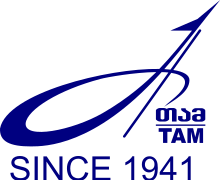
The Sukhoi Su-27 is a Soviet-origin twin-engine supersonic supermaneuverable fighter aircraft designed by Sukhoi. It was intended as a direct competitor for the large US fourth-generation jet fighters such as the Grumman F-14 Tomcat and McDonnell Douglas F-15 Eagle, with 3,530-kilometre (1,910 nmi) range, heavy aircraft ordnance, sophisticated avionics and high maneuverability. The Su-27 was designed for air superiority missions, and subsequent variants are able to perform almost all aerial warfare operations. It was designed with the Mikoyan MiG-29 as its complement.

Pavel Osipovich Sukhoi was a Soviet aerospace engineer and aircraft designer known as the founder of the Sukhoi Design Bureau. Sukhoi designed military aircraft with Tupolev and Sukhoi for 50 years, and produced many notable Soviet planes such as the Sukhoi Su-7, Su-17, and Su-24. His planes set two altitude world records and two world speed records. Sukhoi was honored in the Soviet Union as a Hero of Socialist Labor and awarded the Order of Lenin three times.
The JSC A.S. Yakovlev Design Bureau is a Russian aircraft designer and manufacturer. Its head office is in Aeroport District, Northern Administrative Okrug, Moscow.

The Sukhoi Su-35 is the designation for two improved derivatives of the Su-27 air-defence fighter. They are single-seat, twin-engine, supermaneuverable air superiority fighters, designed by the Sukhoi Design Bureau and built by Sukhoi.

The Sukhoi Su-25 Grach is a subsonic, single-seat, twin-engine jet aircraft developed in the Soviet Union by Sukhoi. It was designed to provide close air support for Soviet Ground Forces. The first prototype made its maiden flight on 22 February 1975. After testing, the aircraft went into series production in 1978 in Tbilisi in the Georgian Soviet Socialist Republic.

The Sukhoi Su-24 is a supersonic, all-weather tactical bomber developed in the Soviet Union. The aircraft has a variable-sweep wing, twin engines and a side-by-side seating arrangement for its crew of two. It was the first of the USSR's aircraft to carry an integrated digital navigation/attack system.

The Sukhoi Su-7 is a swept wing, supersonic fighter aircraft developed by the Soviet Union in 1955. Originally, it was designed as a tactical, low-level dogfighter, but was not successful in this role. On the other hand, the soon-introduced Su-7B series became the main Soviet fighter-bomber and ground-attack aircraft of the 1960s. The Su-7 was rugged in its simplicity, but its Lyulka AL-7 engine had such high fuel consumption that it seriously limited the aircraft's payload, as even short-range missions required that at least two hardpoints be used to carry drop tanks rather than ordnance.

The Sukhoi Su-30 is a twin-engine, two-seat supermaneuverable fighter aircraft developed in the Soviet Union by Russia's Sukhoi Aviation Corporation. It is a multirole fighter for all-weather, air-to-air and air interdiction missions.

The Sukhoi Su-33 is a Soviet/Russian all-weather carrier-based twin-engine air superiority fighter designed by Sukhoi and manufactured by Komsomolsk-on-Amur Aircraft Production Association, derived from the Su-27 and initially known as the Su-27K. Compared with the Su-27, the Su-33 has a strengthened undercarriage and structure, folding wings and stabilators, all for carrier operations. The Su-33 has canards, and its wings are larger than the Su-27 for a slower stall speed. The Su-33 has upgraded engines and a twin nose wheel, and is air refuelable.

The JSCSukhoi Company is a Russian aircraft manufacturer, headquartered in Begovoy District, Northern Administrative Okrug, Moscow, that designs both civilian and military aircraft. It was founded in the Soviet Union by Pavel Sukhoi in 1939 as the Sukhoi Design Bureau. During February 2006, the Russian government merged Sukhoi with Mikoyan, Ilyushin, Irkut, Tupolev, and Yakovlev as a new company named United Aircraft Corporation.

The Sukhoi Su-34 is a Soviet-origin Russian twin-engine, twin-seat, all-weather supersonic medium-range fighter-bomber/strike aircraft. It first flew in 1990, intended for the Soviet Air Forces, and it entered service in 2014 with the Russian Air Force.

The Shenyang J-11 is a 4th generation twin-engine jet fighter of the People's Republic of China derived from the Soviet-designed Sukhoi Su-27. It is manufactured by the Shenyang Aircraft Corporation (SAC). The aircraft is operated by the People's Liberation Army Air Force (PLAAF) and the People's Liberation Army Naval Air Force (PLANAF).

The S-13 is a 122 mm calibre unguided rocket weapon developed by the Soviet Air Force for use by military aircraft. It remains in service with the Russian Aerospace Forces and some other countries.
The PJSC United Aircraft Corporation (UAC) is a Russian aerospace and defense corporation. With a majority stake belonging to the Russian government, it consolidates Russian private and state-owned aircraft manufacturing companies and assets engaged in the manufacture, design, and sale of military, civilian, transport, and unmanned aircraft. Its corporate office is at Leningradsky Avenue, Khoroshyovsky District, Moscow.

The Soviet post-PFI projects are several Soviet and Russian Air Force projects initiated to replace the PFI-era aircraft.

Russian Aircraft Corporation "MiG", commonly known as Mikoyan and MiG, is a Russian aerospace and defence company headquartered in Begovoy District, Moscow.

Aircraft manufacturing is an important industrial sector in Russia, employing around 355,300 people. The dissolution of the Soviet Union led to a deep crisis for the industry, especially for the civilian aircraft segment. The situation started improving during the middle of the first decade of the 2000s due to growth in air transportation and increasing demand. A consolidation programme launched in 2005 led to the creation of the United Aircraft Corporation holding company, which includes most of the industry's key companies. After 2022, reviving the passenger aircraft industry in Russia became the main goal.

TAM Management (TAMM) is a private Georgian military manufacturer which specializes in maintenance, repair, overhaul, design and manufacturing of military, civilian aircraft & air-to-air missiles. It was founded in 2015 on the former territory of "Tbilaviamsheni".


















